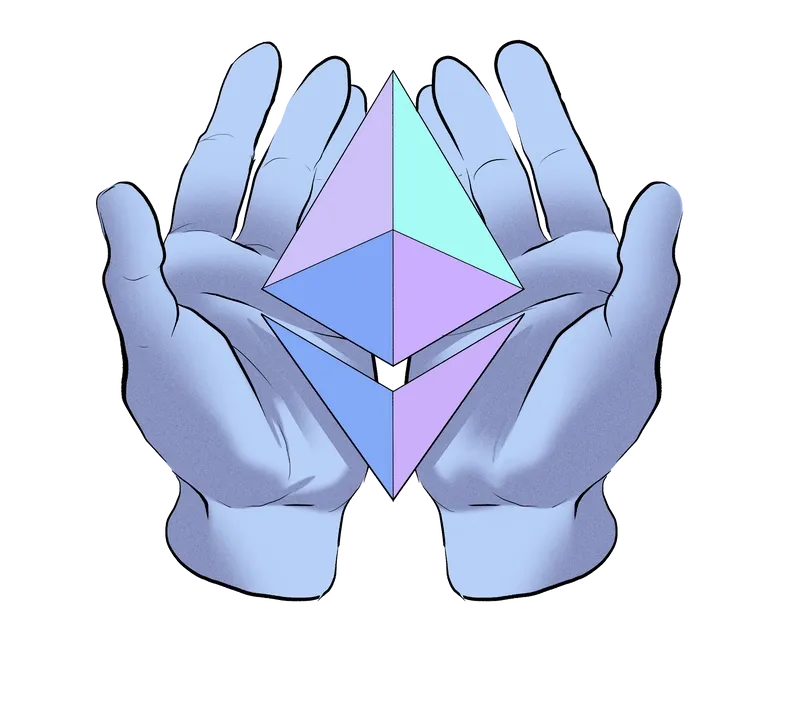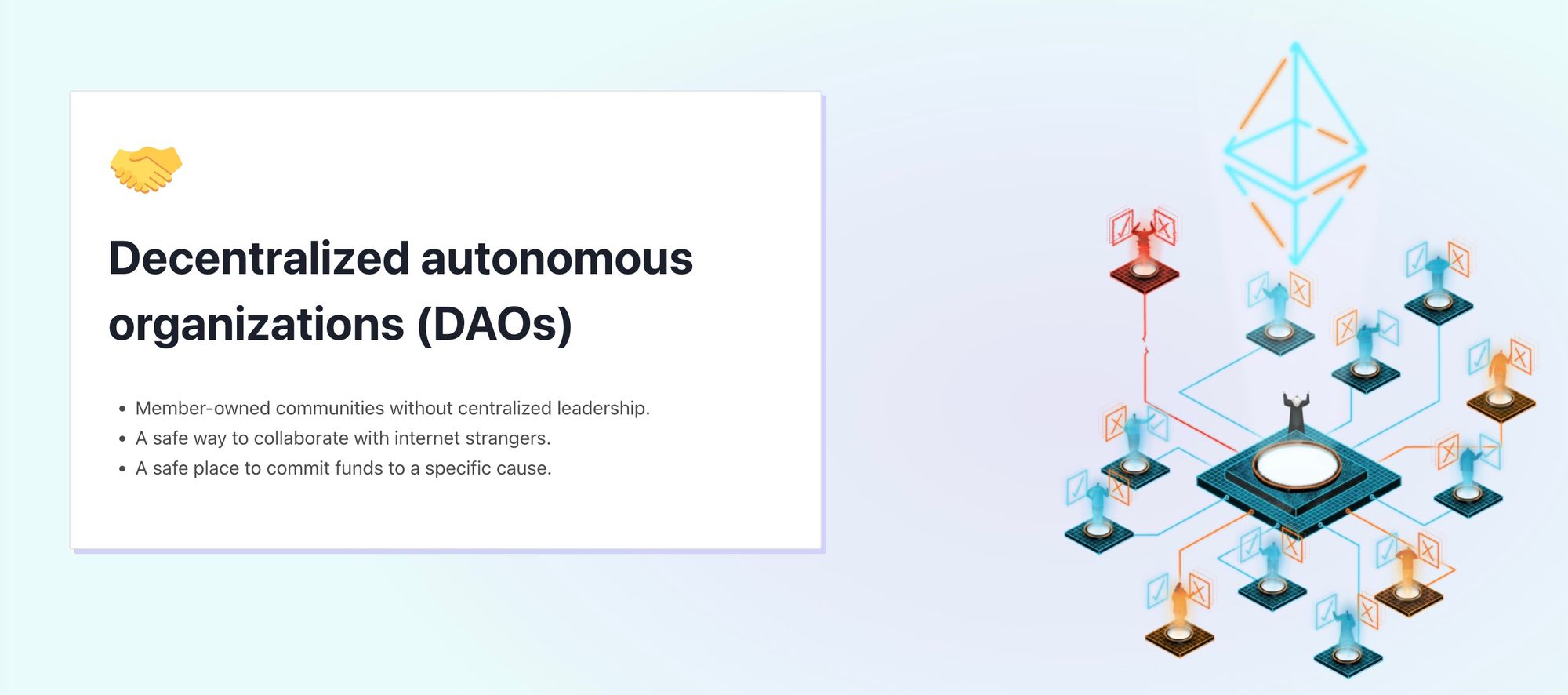Ethereum: What It Is and How It Works
Ethereum is an open-source blockchain, famous for its smart contracts that serves as the foundation for Ether, the cryptocurrency of the Ethereum network.
Let's deep dive into the Ethereum network and its general-purpose blockchain that can be used to power a wide variety of decentralized applications.
| 🔑 Characteristic | Description |
|---|---|
| 🌍 Platform | Ethereum is a decentralized, open-source platform for the creation of smart contracts and decentralized applications (dApps). |
| 🔒 Consensus Mechanism | Ethereum uses a proof-of-stake consensus mechanism. |
| 💻 Programming Language | Ethereum has its own programming language, Solidity, which is used to write smart contracts. |
| 🔑 Tokenization | Ethereum enables the tokenization of assets, including non-fungible tokens (NFTs). |
| 🌌 Applications | Ethereum has a wide range of applications, including gaming, virtual reality, and decentralized finance (DeFi). |
| 🚀 Upgrade | Ethereum is currently undergoing an upgrade, known as Ethereum 2.0, which includes the implementation of sharding to increase scalability. |
What is Ethereum?
Ethereum is a decentralized network and platform based on the blockchain technology. It is widely know for its crypto coin: ether (ETH). However, Ethereum it's much more than just digital currency. It is a versatile platform that allows anyone to create secure, decentralized technology.

Ethereum is designed to be secure, scalable, programmable, and decentralized. It is commonly used by developers and enterprises to create new technologies that can transform various industries and the way we live our lives.
One of the most important functions of Ethereum is its support for smart contracts, which are basically for building decentralized applications (dApps). Several dApps in the decentralized finance (DeFi) space, as well as other sectors, use smart contracts in combination with blockchain technology.
Ethereum, its token ETH, and the use of smart contracts are also important in the world of non-fungible tokens, decentralized autonomous organizations decentralized finance, and also the metaverse.
How Ethereum Works?

Vitalik Buterin, the mastermind behind Ethereum, first presented his vision for the platform in a white paper published in 2014. The following year, Buterin and Joe Lubin, the founder of ConsenSys, a blockchain software company, brought Ethereum to fruition.
Buterin and Lubin were among the pioneers who recognized the boundless potential of blockchain technology beyond simply facilitating secure virtual payments. Their foresight has been vindicated, as Ethereum's ether cryptocurrency has since ascended to become the second-most valuable digital currency, secondo only to Bitcoin in market value.
Ethereum Blockchain Network
Like other cryptocurrencies, Ethereum is based on the blockchain technology to function. The blockchain is a continuously growing chain of blocks, each of which contains information that is added to every new block that is created. A copy of the blockchain is distributed throughout the network, ensuring that all participants have access to the same information.
The blockchain is secured through the use of a network of automated programs that validate transaction information and reach consensus on its validity. This makes it almost impossible to alter the blockchain without the consensus of the network.
Ethereum utilizes the proof-of-stake consensus mechanism, in which a group of participants known as validators work together to create new blocks and verify the information they contain. These blocks include information about the current state of the blockchain, transactions, and attestation data (validator signatures and votes on the validity of the block). The proof-of-stake algorithm enables the Ethereum network to reach consensus and maintain the integrity of the blockchain.
Proof of Stake
In September 2022, Ethereum changed its consensus algorithm to proof-of-stake, which is more sustainable and economical than its previous proof-of-work system.
This new mechanism, called Gasper, includes the Casper-FFG finalization protocol and the LMD Ghost algorithm, which jointly monitor and determine rewards and punishments for validators. Instead of requiring extensive energy consumption to confirm blocks through mining, proof-of-stake relies on validators who pledge a specific amount of ETH (solo validators must commit 32 ETH, while those in a validation pool need to pledge a lesser amount) to vouch for the authenticity of new blocks.
These blocks are then broadcasted to a group of other validators who verify and vote on their validity. Validators who engage in dishonest behavior or try to attack the network may be detected by Gasper and punished by having their staked ETH burned and being removed from the network. Burning refers to sending cryptocurrency to a wallet without any keys, effectively making it unavailable for use.
Wallets
Ethereum users use wallets to keep track of their ether. A wallet is a digital tool that lets you access the ether that is recorded on the blockchain. Your wallet has an address, similar to an email address, that other people use to send you ether in the same way they would send an email.
Please remember that ether is not actually "stored" in your wallet. Instead, your wallet holds the private keys that you use like passwords when you initiate transactions. Each ether that you own is linked to a unique private key, which is necessary for accessing your ether. This is why it is vital to store your keys securely using various methods.
Ethereum vs Ethereum Classic: the split
A very important event in Ethereum's history is the hard fork that resulted in the creation of Ethereum Classic (ETC). In 2016, a group of network participants gained control of the Ethereum blockchain and stole more than $50 million worth of ether, which had been raised for a project called The DAO. The theft was facilitated by a third-party developer associated with the project.
In response to the robbery, the majority of the Ethereum community decided to invalidate the existing Ethereum blockchain and create a new one with a revised history that reversed the theft. However, a small portion of the community chose to preserve the original Ethereum blockchain, leading to a permanent split and the creation of Ethereum Classic.
Ethereum vs Bitcoin
Ethereum and Bitcoin are the two most famous cryptocurrencies, but they are very different. Ethereum is often referred to as "the world's programmable blockchain," as it is designed to be a platform for a wide range of applications, not just a means of payment like Bitcoin.
While the maximum number of bitcoins that can be created is capped at 21 million, there is teoretically no limit to the number of Ether that can be created (there is an annual cap to 18 million ETH, however). As of September 2022, Ethereum uses a proof-of-stake consensus mechanism, while Bitcoin uses the energy-intensive proof-of-work mechanism.
In addition, Ethereum's transaction fees, known as gas, are paid by the users in Ethereum transactions, while the fees for Bitcoin transactions are absorbed by the Bitcoin network.
Ether: the Ethereum token
Ether is the Ethereum cryptocurrency. After the update called "The Merge", Ether became a deflationary crypto.
Ethereum, the second-largest cryptocurrency by market capitalization, has recently undergone a significant change that has made it more attractive to investors. The transition to a proof-of-stake consensus mechanism, known as The Merge, combined with a fee-burning mechanism that was implemented last year, has led to a decline in the supply of Ethereum in circulation. This new mechanism, formally known as EIP-1559, changes the way transaction fees are calculated on the Ethereum blockchain, leading to the burning of part of every transaction fee, slowing down the rate of new Ethereum issuance.
The impact of this change has been amplified by the transition to proof-of-stake, which eliminates the need to pay out rewards to miners. As of mid-November, every new transaction on the Ethereum blockchain is resulting in a reduction in the total coin supply, leading to an increase in the demand for Ethereum and, therefore, putting upward pressure on its price.
This new deflationary trend is significant for investors, as it makes Ethereum a safe haven against inflation. While the U.S. economy is inflating at an 8% clip, Ethereum is deflating, potentially making it more valuable over time. This has led to investors referring to Ethereum as "ultra-sound money" differentiating it from its rival, Bitcoin, which has always been the favorite of both retail and institutional investors.
The decreasing supply of Ethereum, along with its diversified ecosystem consisting of everything from nonfungible tokens and games to decentralized finance protocols and decentralized apps for enterprise users, makes it an attractive long-term investment for those looking to protect their assets from inflation.
The Future of Ethereum
The Ethereum platform has undergone a significant upgrade, which included the transition to the proof-of-stake protocol. This allows users to validate transactions and mint new ETH based on their ether holdings.
The upgrade, formerly known as Eth2, has also introduced the concept of "sharding" to the Ethereum network. Sharding is a process that divides the Ethereum database into smaller parts called shards, which can be worked on by those who have staked ETH. This is similar to the way cloud computing distributes a workload across multiple computers to reduce computational time.
Sharding will grant more validators to work at the same time, speeding up the process of reaching consensus. This is expected to address the chronic network congestion issues that have caused high gas fees on the Ethereum network, and is expected to be implemented sometime in 2023. The upgraded Ethereum platform now consists of two layers: the execution layer, where transactions and validations occur, and the consensus layer, where attestations and the consensus chain are maintained.
NFT
Non-fungible tokens (NFTs) reached popularity in 2021, as a way to tokenize digital assets using the Ethereum blockchain. Tokenization involves assigning a specific digital token to a digital asset, which is then stored on the blockchain and encrypted with the owner's wallet address.
This establishes ownership of the asset and allows it to be traded or sold as a verified transaction on the blockchain. NFTs can be created for a wide variety of assets, including sports tokens, also known as fan tokens, which are like virtual trading cards for fans of certain athletes. These NFTs can be pictures or videos of memorable or historic moments in the athlete's career.
Gaming

Ethereum is also being used in gaming and virtual reality apps. One example is Decentraland, a virtual world that uses the Ethereum blockchain to secure and tokenize items such as land, avatars, wearables, buildings, and environments. This creates a system of ownership within the virtual world.
Another example is Axie Infinity, a game that utilizes blockchain technology and has its own cryptocurrency called Smooth Love Potion (SLP) for rewards and transactions within the game.
DAO

Decentralized Autonomous Organizations (DAOs) are a decentralized way of taking decisions across a distributed network and are being built on the Ethereum network.
For example, let's say you create a venture capital fund and raise money through fundraising, but you want the decision-making process to be decentralized and the distributions to be automatic and transparent.
A DAO could use smart contracts and applications to gather votes from fund members and invest in ventures based on the majority vote of the group, and then automatically distribute any returns.
All transactions would be visible to all parties, and there would be no need for a third party to handle any funds.
The future role of cryptocurrency is uncertain, but Ethereum seems to be poised to play a major role in personal and corporate finance, as well as in many aspects of our modern lives.
DEFI
DeFi, or decentralized finance, uses cryptocurrencies and smart contracts to provide financial services without middleman. In traditional finance, financial institutions act as intermediaries and hold significant power as a result of the money flowing through them. Additionally, billions of people globally do not have access to a bank account.
DeFi endeavors to overcome these challenges by leveraging smart contracts, a type of Ethereum account that can hold and transfer funds based on predefined conditions to facilitate transactions. Smart contracts are open for public inspection and audit and cannot be modified once activated, ensuring their security and transparency.
While it may currently be necessary to rely on more technically proficient members of the Ethereum community to interpret and comprehend the code in smart contracts, the open-source nature of the community keeps developers accountable. As smart contracts become more user-friendly and other means of verifying the trustworthiness of code emerge, this reliance will likely wane.
Bottom line
Ethereum is a decentralized, open-source blockchain platform that enables the creation of smart contracts and decentralized applications (dApps). It was founded in 2014 by Vitalik Buterin with the goal of leveraging blockchain technology for a wide range of applications beyond just a means of payment. Ethereum uses a proof-of-stake consensus mechanism and has its own programming language, Solidity, which is used to write smart contracts.
One of the key features of Ethereum is its ability to tokenize assets, including non-fungible tokens (NFTs), which have gained popularity in recent years. It is also being utilized in a variety of industries, including gaming, virtual reality, and decentralized finance (DeFi).
The future of Ethereum looks bright, as it continues to gain adoption and its capabilities continue to expand. The platform is currently undergoing an upgrade, known as Ethereum 2.0, which includes the implementation of sharding, a process that aims to increase the scalability of the network. This, along with other developments, positions Ethereum well for continued growth and success in the future.
